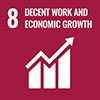Integration of the cost-benefit analysis in managing the prevention of occupational risks
The profitability approach in the management of the prevention of occupational risks entails a search for consensus and pragmatism among prevention entrepreneurs and managers. Since the lack of experiences in the use of preventive socioeconomic indicators has not impregnated risk prevention technicians for different reasons, it causes fear and ignorance when it comes to deciding whether to implement this field of management. Therefore, it is difficult to find parallelisms regarding the recorded data. This places preventive management in the background compared to other areas of management in most organizations. The calculation of costs derived from accidents in companies is a good field to start implementing the necessary integration of the cost-benefit analysis of occupational safety and health in the usual management of them.
ODS



 Carles Salas Ollé
Carles Salas OlléSpecialist Doctor in Occupational Medicine at the University of Barcelona and master in prevention services by the UPC. Technician in Prevention of Occupational Risks in the fields of Industrial Hygiene and of Ergonomics and Applied Psychosociology by the National Institute for Safety and Hygiene at Work, as well as postgraduate diploma in Industrial safety and hygiene from the Polytechnic University of Catalonia, and also PhD in Psychology from the University of Valencia. He has participated and still participates as a regular speaker at national and international forums in prevention of occupational hazards. He has published books and articles on occupational health and prevention of occupational hazards in various specialized journals. He has nearly twenty years of experience in this field. He develops several tasks as a consultant, lecturer and auditor and, in particular, as an associate professor and researcher at the Department of Business Organization of the Polytechnic University of Catalonia (Cerpie). He has participated in the promotion and improvement of labor health and safety as well as working conditions, through interventions in programs in various first-class audiovisual media.



